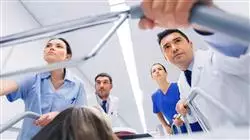University certificate
The world's largest faculty of medicine”
Introduction to the Program
We offer you a quality specialization program with which you can expand your skills in the field of emergency care. A high-level program for professionals seeking to achieve professional success"

Highly qualified healthcare professionals are an added value in patient care with urgent pathologies or in emergency situations, since they demand professionals who are able to respond under pressure with a limited amount of time. On many occasions, speed is essential to save a life, and a mistake during intervention can mean life or death for patients. For this reason, emergency professionals must have superior knowledge and constantly update their skills, allowing them to provide quality care, both in-hospital and out-of-hospital services.
To achieve such high-quality care, TECH has assembled the best team of professionals to develop this Advanced master’s degree with specific content on emergency medicine. A fully up-to-date program in which you can find the latest information in this field. The program covers current issues from high-risk infectious diseases, pandemics and protocols required in emergency departments, to toxicology and rare diseases. Extensive and diverse content with which to obtain an overview of all the pathologies that can be found in emergency care, but without losing the depth and quality of content that all health education must have to be able to apply it in practice.
Throughout this specialization program, students will learn all of the current approaches to the different challenges posed by their profession. A high-level step that will become a process of improvement, not only on a professional level, but also on a personal level. This challenge is one of TECH's social commitments: to help highly qualified professionals specialize and develop their personal, social and work skills during the course of their studies.
We will not only take you through the theoretical knowledge we offer, but we will introduce you to another way of studying and learning, one which is simpler, more organic, and efficient. We will work to keep you motivated and to create in you a passion for learning. And we will push you to think and develop critical thinking.
Immerse yourself in an intensive study of Emergency Medicine and boost your career”
This Advanced master’s degree in Accident and Emergency Care is the most comprehensive and up-to-date course on the university scene. The most important features include:
- The latest technology in e-learning software
- Intensely visual teaching system, supported by graphic and schematic contents that are easy to assimilate and understand
- Practical case studies presented by practising experts
- State-of-the-art interactive video systems
- Teaching supported by telepractice
- Continuous updating and recycling systems
- Self-regulated learning: full compatibility with other occupations
- Practical exercises for self-assessment and learning verification
- Support groups and educational synergies: questions to the expert, debate and knowledge forums
- Communication with the teacher and individual reflection work
- Content that is accessible from any fixed or portable device with an Internet connection
- Supplementary documentation databases are permanently available, even after the education has ended
An educational program created for professionals who aspire to excellence that will allow you to acquire new skills and strategies in a smooth and effective way"
Our teaching staff is made up of working professionals. In this way, we ensure that we provide you with the up-to-date education we are aiming for. We have a multidisciplinary team of qualified and experienced professionals in different environments, who will carry out the theoretical knowledge in an efficient way, but above all, they will put at the service of the specialization the practical knowledge derived from their own experience.
This command of the subject is complemented by the effectiveness of the methodological design of this program. Developed by a multidisciplinary team of e-learning experts, it integrates the latest advances in educational technology. In this way, you will be able to study with a range of easy-to-use and versatile multimedia tools that will give you the necessary skills you need for your specialization.
The design of this program is based on Problem-Based Learning, an approach that conceives learning as a highly practical process. To achieve this remotely, we will use telepractice. With the help of an innovative, interactive video system and Learning from an Expert, students can acquire the knowledge as if you were facing the scenario you are learning at that moment. A concept that will make it possible to integrate and fix learning in a more realistic and permanent way.
We have the best teaching methodology and a multitude of simulated cases that will help you train in real situations"

A deep and complete immersion into the most updated strategies and approaches, which will allow you to acquire useful knowledge to apply in your profession"
Why study at TECH?
TECH is the world’s largest online university. With an impressive catalog of more than 14,000 university programs available in 11 languages, it is positioned as a leader in employability, with a 99% job placement rate. In addition, it relies on an enormous faculty of more than 6,000 professors of the highest international renown.

Study at the world's largest online university and guarantee your professional success. The future starts at TECH”
The world’s best online university according to FORBES
The prestigious Forbes magazine, specialized in business and finance, has highlighted TECH as “the world's best online university” This is what they have recently stated in an article in their digital edition in which they echo the success story of this institution, “thanks to the academic offer it provides, the selection of its teaching staff, and an innovative learning method aimed at educating the professionals of the future”
A revolutionary study method, a cutting-edge faculty and a practical focus: the key to TECH's success.
The most complete study plans on the university scene
TECH offers the most complete study plans on the university scene, with syllabuses that cover fundamental concepts and, at the same time, the main scientific advances in their specific scientific areas. In addition, these programs are continuously being updated to guarantee students the academic vanguard and the most in-demand professional skills. In this way, the university's qualifications provide its graduates with a significant advantage to propel their careers to success.
TECH offers the most comprehensive and intensive study plans on the current university scene.
A world-class teaching staff
TECH's teaching staff is made up of more than 6,000 professors with the highest international recognition. Professors, researchers and top executives of multinational companies, including Isaiah Covington, performance coach of the Boston Celtics; Magda Romanska, principal investigator at Harvard MetaLAB; Ignacio Wistumba, chairman of the department of translational molecular pathology at MD Anderson Cancer Center; and D.W. Pine, creative director of TIME magazine, among others.
Internationally renowned experts, specialized in different branches of Health, Technology, Communication and Business, form part of the TECH faculty.
A unique learning method
TECH is the first university to use Relearning in all its programs. It is the best online learning methodology, accredited with international teaching quality certifications, provided by prestigious educational agencies. In addition, this disruptive educational model is complemented with the “Case Method”, thereby setting up a unique online teaching strategy. Innovative teaching resources are also implemented, including detailed videos, infographics and interactive summaries.
TECH combines Relearning and the Case Method in all its university programs to guarantee excellent theoretical and practical learning, studying whenever and wherever you want.
The world's largest online university
TECH is the world’s largest online university. We are the largest educational institution, with the best and widest online educational catalog, one hundred percent online and covering the vast majority of areas of knowledge. We offer a large selection of our own degrees and accredited online undergraduate and postgraduate degrees. In total, more than 14,000 university degrees, in eleven different languages, make us the largest educational largest in the world.
TECH has the world's most extensive catalog of academic and official programs, available in more than 11 languages.
Google Premier Partner
The American technology giant has awarded TECH the Google Google Premier Partner badge. This award, which is only available to 3% of the world's companies, highlights the efficient, flexible and tailored experience that this university provides to students. The recognition as a Google Premier Partner not only accredits the maximum rigor, performance and investment in TECH's digital infrastructures, but also places this university as one of the world's leading technology companies.
Google has positioned TECH in the top 3% of the world's most important technology companies by awarding it its Google Premier Partner badge.
The official online university of the NBA
TECH is the official online university of the NBA. Thanks to our agreement with the biggest league in basketball, we offer our students exclusive university programs, as well as a wide variety of educational resources focused on the business of the league and other areas of the sports industry. Each program is made up of a uniquely designed syllabus and features exceptional guest hosts: professionals with a distinguished sports background who will offer their expertise on the most relevant topics.
TECH has been selected by the NBA, the world's top basketball league, as its official online university.
The top-rated university by its students
Students have positioned TECH as the world's top-rated university on the main review websites, with a highest rating of 4.9 out of 5, obtained from more than 1,000 reviews. These results consolidate TECH as the benchmark university institution at an international level, reflecting the excellence and positive impact of its educational model.” reflecting the excellence and positive impact of its educational model.”
TECH is the world’s top-rated university by its students.
Leaders in employability
TECH has managed to become the leading university in employability. 99% of its students obtain jobs in the academic field they have studied, within one year of completing any of the university's programs. A similar number achieve immediate career enhancement. All this thanks to a study methodology that bases its effectiveness on the acquisition of practical skills, which are absolutely necessary for professional development.
99% of TECH graduates find a job within a year of completing their studies.
Advanced Master's Degree in Accident and Emergency Care
Emergency medical care requires highly trained medical personnel to attend to the symptoms presented by critically ill patients, not only because of their degree of complexity, but also because of the risk they represent to the patient's life. In addition to a high quality service, the attention of these professionals must be fast and effective to respond to these first order needs, whether in a hospital or outpatient setting. At TECH Global University we developed the Advanced Master's Degree in Accident and Emergency Care, a program focused on addressing the most relevant concepts and topics to specialize in this discipline. With a graduate degree of high academic level you will have the opportunity to achieve academic and professional excellence.
Specialize in the largest School of Medicine
At the largest School of Medicine you will have the opportunity to access a first class postgraduate program, equipped with the most advanced technological and human resources to develop your skills in the field of Emergency Medicine. So, you will review the fundamentals of emergency health care; you will apply clinical and non-clinical skills in emergency medicine, prioritize, organize and manage care in a more efficient way through triage. You will also handle frequently used drugs and identify the various trauma pathologies of critically ill patients. This will allow you to solve complex risk and emergency situations in real environments and stand out through excellence. With our Advanced Master's Degree you will enhance your professional growth and advance in your professional goals.







